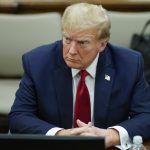In recent weeks, there’s been considerable discussion about the campaign of Kamala “Queen of Word Salads” Harris and Tim “Great Walz of China,” which appears to be collapsing. This seemed almost inevitable. Kamala Harris may be the weakest candidate since Hillary Clinton, perhaps even weaker, though that benchmark is already far below ground level.
At UnHerd, Emily Jashinsky, the site’s Washington correspondent, shares her insights on the end of what the media refers to as Kamala Harris’s “honeymoon” period and why it’s clearly over. As expected, I have my own thoughts on the matter.
Emily writes:
This is the race Democrats feared. Less than a month before the US election, Donald Trump is regaining the slight edge he held before Democrats convened in Chicago to nominate Kamala Harris. According to the RealClearPolitics polling average in battleground states, Trump trailed Harris from late August until late September. Now, though, he’s back on top at 48.4 to 48.1. His lead may be fractional — and Harris is up two points in the popular vote — but the numbers have Kellyanne Conway feeling good.
That may be true—Harris is trailing in the averages across all battleground states and has lost her significant lead in the (ugh) “national popular vote.” However, the last two polling cycles in 2016 and 2020 significantly underestimated support for Republican candidates.
Alongside a picture of the RCP numbers, the pollster argued this week that Trump is “in his best polling ever era, even as media outlets are likely undercounting his voters — again”. On CNN, Harry Enten crunched the numbers too. “Let’s say we have a polling miss like we had in 2020. What happens then?” he asked on Tuesday. “Well, then Donald Trump wins the election in a blowout with 312 electoral votes.”
Emily is right. This is the scenario Democrats dreaded, and they should have anticipated it. Ultimately, it’s their own doing. The choice of her running mate didn’t help, either. She could have selected a governor from a swing state like Josh Shapiro, who could have secured Pennsylvania’s crucial electoral votes, but he is Jewish, and Harris didn’t want to alienate the Hamas caucus. Instead, she opted for Tim Walz, whose alignment with Communist China offers little value.
In contrast, Donald Trump made a strong choice in JD Vance: an intelligent and accomplished writer and speaker who is gaining prominence daily.
At the same time, a civil war seems to be brewing within the Democratic Party over this situation—and if Kamala Harris loses, which seems increasingly likely, it could erupt.
This might actually be beneficial. The current mainstream of the Democratic Party would consider figures like Harry Truman or John F. Kennedy as extreme right-wingers, which doesn’t bode well for the party’s longevity. Kamala Harris is, however, far left even among today’s Democrats—and that’s a significant part of her challenge.
The risk aversion that characterised Harris’s campaign before Labor Day might be her best bet. Tack to the centre, stick to the script, and stay the hell away from Bill Whitaker. Perhaps remaining a blank slate for some small group of undecided voters is better than Harris trying to define herself at all.
Remaining a blank slate won’t work. Not this year. Too much is known about Kamala Harris already. What’s more, nobody with enough brains to pound sand is going to buy any sudden tack to the center. The “risk aversion that characterized Harris’s campaign before Labor Day” isn’t her best bet – it’s what got her in this position in the first place, and the only other option is to come out as what she really is: A far-left ideologue who is lazy, poorly informed, not very bright, and unsuited to be president of the United States.











